

What Is Web 2.0. By Tim O'Reilly 09/30/2005 Oct. 2009: Tim O'Reilly and John Battelle answer the question of "What's next for Web 2.0? " in Web Squared: Web 2.0 Five Years On. The bursting of the dot-com bubble in the fall of 2001 marked a turning point for the web. Many people concluded that the web was overhyped, when in fact bubbles and consequent shakeouts appear to be a common feature of all technological revolutions. Shakeouts typically mark the point at which an ascendant technology is ready to take its place at center stage. Don Tapscott - Macrowikinomics - full show. Noophere and the Semantic Web. For those of you interested in the next big thing in the Internet world, I'd like to share with you a little graphic I found linking Web 3.0 (the Semantic Web) with the Noosphere.

Everyone knows by now about Web 2.0 and social networking, Facebook, Twitter, blogs, 4square, etc. Web 3.0 linking the data and the people together is upon us. There are already meetups all over the country on groups working to evangelize the next generation of the Internet. SmartSystem. File-Sharers Await Official Recognition of New Religion. A group of self-confessed radical pirates are pinning their hopes on gaining official recognition of their own unique belief system.

The founders of the Missionary Church of Kopimism - who hold CTRL+C and CTRL+V as sacred symbols - hope that along with this acceptance will come harmony, not just with each other, but also with the police. ‘Thou shall not steal’ is one of the most well-known of the Ten Commandments. Although most familiar to those in Christian circles, its message is universal and cuts across most religious boundaries.
But while stealing – taking another’s property and therefore depriving him of it – is widely frowned upon, some have a wider definition for the word. Make no mistake, if the entertainment industries were God passing their sacred rulings to Moses, there would have almost certainly been one more – Thou Shalt Not Copy. Internet Engineering Task Force. The reason that it was so easy to disconnect a... Designing a new Internet with more choices.
Partial map of the Internet based on the January 15, 2005 data found on opte.org A team of researchers from four U.S. universities is poised to lay out the key components for a networking architecture to serve as the backbone of a new Internet that gives users more choices about which services they use.

The National Science Foundation (NSF) asked the researchers to design a blueprint for a future version of the Internet. Making choices The new Internet architecture will hinge on users being able to make choices about which features and services they want to use, and which entities they want to pay to provide those services. As such, the work being done under the NSF grant is guided by three principles: 1). 2). The connective (connectivenet) Social Networking 3.0: From Self-expression to Group Action. My favorite social networking site is one that makes $10B of revenues/year, has no infrastructure costs, and has no salesforce, has no management team.
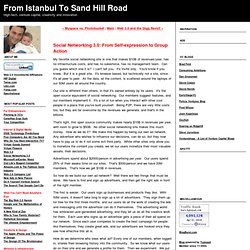
8 Steps...(T.G) 8- Global Brain. Kevin Kelly on the next 5,000 days of the web. Joël de Rosnay : À la découverte du Web 5.0. Joël de Rosnay est un biologiste français, d’abord spécialiste des origines du vivant et des nouvelles technologies, puis en systémique et en prospective.
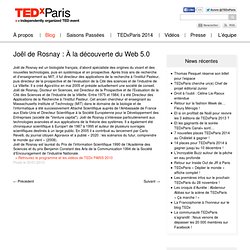
Après trois ans de recherche et d’enseignement au MIT, il fut directeur des applications de la recherche à l’Institut Pasteur, puis directeur de la prospective et de l’évaluation de la Cité des sciences et de l’industrie de La Villette. Il a créé AgoraVox en mai 2005 et préside actuellement une société de conseil. Joël de Rosnay, Docteur en Sciences, est Directeur de la Prospective et de l’Evaluation de la Cité des Sciences et de l’Industrie de la Villette. Entre 1975 et 1984, il a été Directeur des Applications de la Recherche à l’Institut Pasteur. > Retrouvez le programme et les vidéos de TEDx PARIS 2010. Web 5.0. Kevin Kelly. Kevin Kelly: Technology as a Living Force. Du Web² au Web 4.0, en passant par le Web 3.0 : Où en sommes nous ? RadarNetworksTowardsAWebOS1.jpg (Image JPEG, 1078x688 pixels)
Du web 1.0 au web 4.0: l'évolution du web depuis 1990. Buzz word ou réalité?
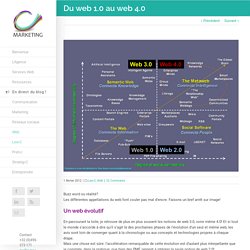
Les différentes appellations du web font couler pas mal d’encre. Faisons un bref arrêt sur image! 08-11-06-MikeEvans-Web.pdf (Objet application/pdf)
La troisième frontière du Web. Chacun sent que le Web entre aujourd’hui dans une nouvelle phase de son développement.
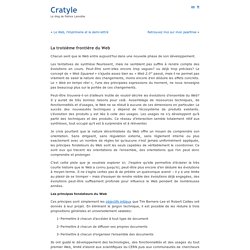
Les tentatives de synthèse fleurissent, mais ne semblent pas suffire à rendre compte des évolutions en cours. Peut-être sont-elles encore trop vagues? Ou déjà trop précises? Synaptic Web. Stay updated about the Synaptic Web on Twitter via @SynapticWeb The Synaptic Web By Khris Loux, Eric Blantz, Chris Saad and you...
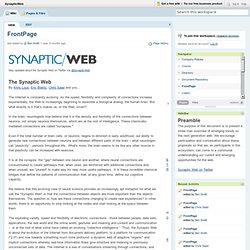
The Internet is constantly evolving. As the speed, flexibility and complexity of connections increase exponentially, the Web is increasingly beginning to resemble a biological analog; the human brain.
Report: 51% of web site traffic is 'non-human' and mostly malicious. Incapsula, a provider of cloud-based security for web sites, released a study today showing that 51% of web site traffic is automated software programs, and the majority is potentially damaging, -- automated exploits from hackers, spies, scrapers, and spammers.

The company says that typically, only 49% of a web site's visitors are actual humans and that the non-human traffic is mostly invisible because it is not shown by analytics software. 2020 Predictions -Model for Future Innovations. Filed under applications, consumer behavior, internet behavior, Internet of Things, location, mobile web, Predictions, purchase, Trend Spotting Behavior, trends, Trends Review Based on the concept of “The Internet of Things” TrendsSpotting has developed a working model for NPD. ”The ANA Model” was developed and implemented while working with tech companies, and allows us to predict future products and services.
The “ANA Model” identifies the process where data is collected from reported “Actions”, then delivered to predefined monitor systems or professionals by “Notifications”. The outcomes can “Alert” people through a visualized system. Few daily activities are presented to reflect the process. The ANA model can not only predict potential products and services (shopping, health, transportation, advertising etc) but can suggest new professions to rise. Tweet This Post Plurk This Post Buzz This Post Delicious Digg This Post Ping This Post Reddit Stumble This Post. The Rise of the Personal Intelligent Search Agent. 3.0 Semantic Web.